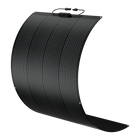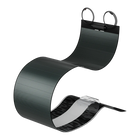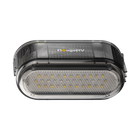Why CIGS Solar panels are best suitable for boats?

Whether for a weekend or a week-long getaway with family or friends, being on the water provides the perfect environment for relaxing everyone from monotony and stress, bringing them back to themselves and closer to their near and loved ones.
Boating provides the ideal setting for bonding that you always deserve. The rush of wind through your loved one’s hair, the bright smiles of a child in anticipation, and the relaxed face of your friend in the sun on the boat make some images we always adore.
Everything must be in order if you want to make the most of your boating hours and have the vacation of a lifetime. There are plenty of chilled beverages, cooking stoves and ovens, BBQ grills, and a full-fledged music system.
To be practical, you need a full-fledged power system so that all these appliances can run as needed and you are never in a messy situation on the boat. Solar panels are the best option we recommend. There are monocrystalline and polycrystalline solar panels, as well as CIGS panels, which are the most recent addition. In fact, CIGS panels are ideal for boats. Let us investigate the reason.
- Types of solar panels:
- Roof types of a boat and a house
- Why CIGS panels are best suited to boats?
- Conclusion
- FAQs
Types of solar panels:
Let us briefly see the types of solar panels before diving deep into the CIGS variety. There are three main varieties of solar panels – mono-crystalline, poly-crystalline, and thin film solar panels.

The images above show the mono-crystalline, poly-crystalline, and thin-film CIGS panels. Mono and poly panels are rigid with an aluminum frame with glass on top. They are widely used for building rooftop and large ground-mounted utility-scale solar power plants.
But the CIGS panels are very thin, lightweight, and flexible. That is the biggest advantage for CIGS solar panels to install on the boat, where the ground to fix the panel is curved, and cannot take heavyweight panels when the power system is moving.
Roof types of a boat and a house

Fig 1: Curved nature of boat roof and other surfaces made up of lighter material
 Fig 2: Tougher and Stronger roof of a house
Fig 2: Tougher and Stronger roof of a house
It is evident that the roofs of a boat and a house are distinctly different. The boat roofs are curved in nature and made up of lighter material. But the house roof is rugged and supported by stronger structural materials like steel and wood. Moreover, the surface of a house roof is not curved. Therefore, the house roof has the structural strength to hold heavier solar panels.
Why CIGS panels are best suited to boats?
Thin Film CIGS solar panels have several advantages for boat application. We will explain them in detail.
Flexible and Lightweight
The flexible nature of the CIGS solar panel makes it suitable for boats’ curved surfaces. CIGS panels are easy to install. Almost plug-and-play without any installation hassles. And lightweight makes it safer to install on a boat roof.
A mono or a polycrystalline panel is approximately 5 times heavier than a CIGS panel of a similar watt panel. For example, a 200W polycrystalline solar panel may weigh 16 kg and a 200W CIGS panel is only 3 kg. Meanwhile, the CIGS panel has no frame and no glass. That makes these panels lighter. A 100 Flexible CIGS panel from BougeRV weighs only 1.7kg.
No mounting rack is needed for flexible CIGS panels
Heavy metallic racks are required to fix the crystalline solar panels on the ground. It requires drilling and tightening to keep the solar panels firmly in place. The racking must be heavier to save the heavier crystalline solar panels from wind gusts. As we are aware that wind speed at the sea is generally high as it is a vast open space.
Moreover, when a boat moves on water, it creates much wind pressure. On the other hand, a roof of a residence has the structural strength to hold the load of these panels, but boat roofs are designed to be thinner and lighter. The more the boat becomes heavy, the more fuel it will consume.
CIGS panels are simple to install
 Fig 3: Front and rear side or a BougeRV 100W flexible CIGS panel
Fig 3: Front and rear side or a BougeRV 100W flexible CIGS panel
Installation of solar panels requires only two easy steps. First, peel the protection tape, and second attach the panel to the roof or any surface of the boat. Then connect the panel to the battery controller and the solar panel is ready to work.
This will save a lot of effort and cost comparing monocrystalline and polycrystalline solar panels. One needs professional help to choose the right kind of racking and install that. It requires time and skilled manpower.
No risk of breakage, cell microcracks, and energy loss
Crystalline modules are vulnerable to breakage and cracks for two main reasons:
- Cell Structure
- Use of glass
Cell-structure of crystalline panels:
Cells of mono and polycrystalline solar panels are made up of thin wafers that are very brittle. That needs to be handled very carefully during panel manufacturing, transportation, handling and operation, and maintenance. This type of module is not suitable for the vibration of the boat. There is every possibility of microcracks in the panel that will reduce its performance.
Use of glass:
As the flexible CIGS panels have no glass, there is no risk of glass breakage in hailstorms, in handling, and in maintenance. In the case of crystalline panels, there are risks of panel damage in hailstorms and if someone steps on it during cleaning and maintenance, that may create microcracks in panels. Microcracks reduce the performance of the panel. But in the case of CIGS panels, these risks can be avoided as the cells are made up of thin film technology.
Works better in low light and shadow
Technically, CIGS is a “direct band gap material”, it can absorb maximum sunlight with a 1 to 2-micron thin solar cell. Whereas crystalline silicon requires 160 to 190-micron cells. Also, crystalline cells are single-junction cells, but the CIGS cells are heterojunctions.
As we know that light coming from the sun is an electromagnetic wave and there are different wavelengths in it. These two factors (heterojunction and band gap material) help CIGS panels to absorb more wavelengths in the light spectrum. For that, the CIGS panels work better under low lights. This means it starts working early in the morning and works longer in the afternoon producing more energy compared to crystalline panels.
CISG panels are aesthetically pleasing on a boat
The final and most compelling reason to choose CIGS panels for boats is that CIGS panels fitted on the boat surfaces are aesthetically pleasing. For crystalline panels to fit, metal racking systems are needed to be installed and that looks clunky.
Conclusion
The boats provide the ideal setting for family and friends to unwind and bond. Going inside nature to get away from the stresses of everyday life is a rejuvenating experience. That is exactly what we intend to do in a calm, collected, and assured manner.
Solar is clean and environmentally friendly. From the installation point, flexible CIGS panels are the perfect match on curved boat surfaces. It is quick and easy to install and aesthetically pleasing. As CIGS panels work in low light in the early morning hours and late afternoon, they produce more energy which is good for battery life.
If you find the article interesting or want some advice, visit BougeRV. At BougeRv we are dedicated and experienced to help you find the right CIGS panels for your boat. Just leave your name and contact details and requirement here. Our team will contact you to assist you. Our services are free and non-binding.
FAQs
Why monocrystalline or polycrystalline panels are not suitable for boats?
First, monocrystalline or polycrystalline solar panels are heavy and rigid in nature. Second, it needs a metal racking system to fix firmly on the ground. Third, the tilted surface of the rigid panels invites trouble from the wind. Heavy wind gust can uproot the panels and creates a danger to boat navigation.
Where to buy the best CIGS panels?
Buying CIGS panels are tricky. As crystalline solar panels occupy 90% of the solar panel market in the solar power industry, getting suppliers for niece areas like powering boats is few. At BougeRV we are dedicated to making your vacation feature-rich, safe, and trouble-free. We supply the best CIGS panels in the market for boat applications.
How to install the CIGS panels?
CIGS panels from BougeRV are the quickest DIY. One needs to only peel the protective tape on the back side and attach it to the boat roof or other surfaces. Then you can connect the positive and negative cables to the battery controller and the CIGS panels are ready to work.
You can also see our complete guide and manual for installing CIGS when shipping with the product.




































